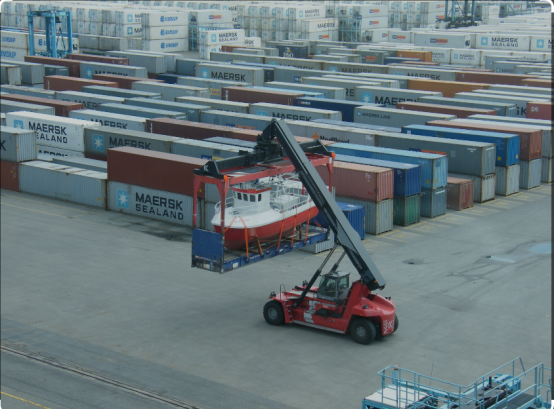A flat rack container is one of several types of types of containers that exist in maritime transport, usually made of steel, which is used to transport goods internationally when they cannot be stored in a standard container.
A flat rack container is open and has only panels or support posts at the ends, allowing the dimensions of the cargo to exceed its volume at the top or sides.
Once the goods are loaded onto a flat rack, they are perfectly secured by a mechanism of straps and slings that are anchored to the container's security points. This is very similar to the process used to secure the cargo on a flat bed trailer.
Once the container is secured, special cranes or platforms are used to transport it to a ship. Unlike standard containers, flat racks cannot always be stacked on top of each other, so they require a higher level of logistics and care when loaded onto a container ship.
When is a flat rack container used?
Typically, the flat rack is required for the transport of out-of-gauge (OOG) cargo that is too wide or too tall to fit in a twenty- or forty-foot container.
A very simple and intuitive way to know if you are going to need a flat rack container in an international freight shipment, is when you already use open containers to transport your products by land, because that means that it probably won't fit in a sea container either. Either way, it's best to always check with your Freight forwarder or specialized logistics agency.
Many times, the flat rack is used for goods that, strictly speaking, would fit in a 40-foot container, but would be very complicated to accommodate. In this case, it is preferred to use a more specialized container instead of spending additional hours and efforts of the loading personnel. At the end of the day, it's all about cost.
Some examples of goods that are usually best transported in a flat rack are:
Heavy machinery
Construction equipment
Bulk goods
Transformers
Boilers and/or tanks
Cranes
Piping and tubing
Turbines
Automobiles
Steel and glass plates
It is important to consider that the weight of many goods is not always distributed evenly across the base of the container. In these cases, we must always make sure not to exceed the so-called concentrated load limit, which is usually about two thousand to four thousand kilograms per square foot.
What are the different types of flat rack containers?
Flat racks, like traditional containers, can be either twenty or forty feet, allowing them to be stacked on top of a normal container. A twenty-foot flat rack has a payload capacity of approximately thirty thousand kilos and is almost six meters long. A forty-foot flat rack holds up to forty thousand kilos and is over twelve meters long.
Additionally, there are two types of flat rack models used in shipping:
Flat rack with fixed sides: As the name suggests, the end panels cannot be folded down or folded up. This type of container is easier to handle, but at the same time can only carry cargo that fits well along its length.
Drop-side flat rack: this is the only option when it is necessary to drop one or both end panels. The loading logistics are more complex, but it allows much larger machinery or equipment to enter.
What are the disadvantages of flat rack containers?
Although flat rack containers are usually one of the best alternatives for oversized cargo, the reality is that they have some drawbacks compared to traditional containers. The three most important are the following:
They may be more difficult to obtain: there is currently a widespread shortage of containers as a result of the pandemic, which, although now normalizing, is still particularly acute for flat racks.
They are more expensive: since they are more specialized equipment, the rent and especially the logistics of loading a flat rack can be higher than with a normal container, for example, due to the need to use a special crane.
Cargo is exposed: unlike a closed container, in a flat rack the cargo is not covered and this makes it even more vulnerable to the elements and the salinity of the ocean. Although this is not necessarily a problem, sometimes special tarpaulins must be used to protect the cargo, which obviously increases costs.
They are not multimodal: standard containers are designed to be loaded onto trailers and then unloaded directly at the port and from there onto the cargo ship. This is not the case with flat racks, which means that, almost always, the goods must first be unloaded from their land vehicle and then loaded and secured on the flat rack, which means, in addition to more time, more risk of damage to the goods.
Written by Luis
